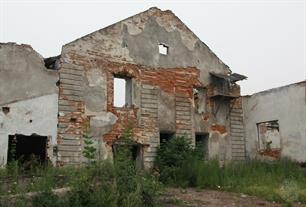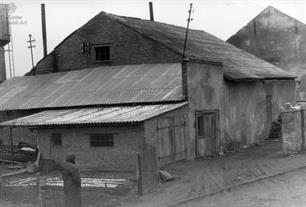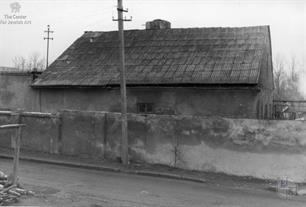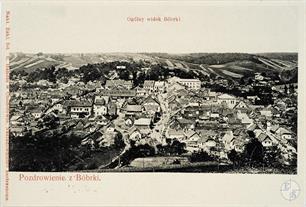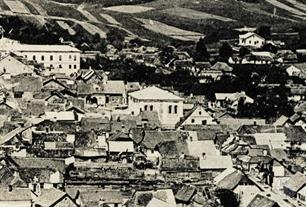Bibrka
Lviv district, Lviv region
Sources:
- Pinkas Hakehillot Polin: Encyclopedia of Jewish Communities, Poland, Volume II, published by Yad Vashem, Jerusalem.
- Russian Jewish encyclopedia
- Virtual Shtetl. Bobrka
- Krugłow A. I., Bobrka. Holokost na teritorii SSSR. Encyklopedia, ed. I. A. Altman, Moscow 2009, p. 90.
Photo:
- Eugene Shnaider
- Bohdan Baran, Center for Jewish art. Beit Midrash in Bibrka
- Albin Friedrich. Biblioteka Narodowa Polona. Bobrka
- Pinkas Hakehillot Polin: Encyclopedia of Jewish Communities, Poland, Volume II, published by Yad Vashem, Jerusalem.
- Russian Jewish encyclopedia
- Virtual Shtetl. Bobrka
- Krugłow A. I., Bobrka. Holokost na teritorii SSSR. Encyklopedia, ed. I. A. Altman, Moscow 2009, p. 90.
Photo:
- Eugene Shnaider
- Bohdan Baran, Center for Jewish art. Beit Midrash in Bibrka
- Albin Friedrich. Biblioteka Narodowa Polona. Bobrka
The first mention of the city is found in the Galician-Volyn Chronicle in 1211.
The settlement was the property of the Polish king.
In 1469, the Bibrka received the privilege of Casimir IV in 1469, Magdeburg law, according to which it was allowed to arrange a fair twice a year and conducted bidding once a week.
Since 1920, Bibrka has been part of the Lviv Voivodeship of the Polish Republic.
Since 1939, the city became part of the Ukrainian SSR.
In 1765, 713 Jews lived in Bibrka,
in 1859, 1778 Jews (63% of the total population),
in 1890 - 2395 Jews (48.5%),
in 1921, 1480 Jews (33.7% of the total population),
in 1931 - 1833 Jews.
Probably, the first Jews arrived in Bibrka already in the fifteenth century. Jewish taxpayers are mentioned in the media in the documents of 1625 and 1661. At that time, the Jews of Bibrka belonged to Lviv Kahal.
On the Yiddish, the name of the shtetl sounded like "Boyberke".
During fairs in Bibrka, congresses of representatives of the Kahals from all Voevodships (1722, 1753) took place.
In the first years after the Bibrka joined the Austria-Hungary, the Jewish-German school was opened in 1806. Home weaving was developed in Bibrka. Bibrka's fabrics were famous for their quality and sold in Gdansk and Vienna.
To the beginning of the 19th century almost all the weavers in Bibrka were Jews.
In the end of 19 - beginning of the 20th century Jews of the Bibrka earned a living by trading, craft, and transporting. Bread and skin trade was also concentrated in the hands of Jews. Several large Jewish merchants were engaged in the sale of tobacco, salt, oil and alcohol.
In the end of the 19th century there were 3 Jewish lawyers in Bibrka, to the beginning of 1 World War - 6 lawyers there was a Jews.
In 1880s the mass exit to the United States began. In 1908, a community of immigrants from Bibrka was created in New York.
The settlement was the property of the Polish king.
In 1469, the Bibrka received the privilege of Casimir IV in 1469, Magdeburg law, according to which it was allowed to arrange a fair twice a year and conducted bidding once a week.
Since 1920, Bibrka has been part of the Lviv Voivodeship of the Polish Republic.
Since 1939, the city became part of the Ukrainian SSR.
In 1765, 713 Jews lived in Bibrka,
in 1859, 1778 Jews (63% of the total population),
in 1890 - 2395 Jews (48.5%),
in 1921, 1480 Jews (33.7% of the total population),
in 1931 - 1833 Jews.
Probably, the first Jews arrived in Bibrka already in the fifteenth century. Jewish taxpayers are mentioned in the media in the documents of 1625 and 1661. At that time, the Jews of Bibrka belonged to Lviv Kahal.
On the Yiddish, the name of the shtetl sounded like "Boyberke".
During fairs in Bibrka, congresses of representatives of the Kahals from all Voevodships (1722, 1753) took place.
In the first years after the Bibrka joined the Austria-Hungary, the Jewish-German school was opened in 1806. Home weaving was developed in Bibrka. Bibrka's fabrics were famous for their quality and sold in Gdansk and Vienna.
To the beginning of the 19th century almost all the weavers in Bibrka were Jews.
In the end of 19 - beginning of the 20th century Jews of the Bibrka earned a living by trading, craft, and transporting. Bread and skin trade was also concentrated in the hands of Jews. Several large Jewish merchants were engaged in the sale of tobacco, salt, oil and alcohol.
In the end of the 19th century there were 3 Jewish lawyers in Bibrka, to the beginning of 1 World War - 6 lawyers there was a Jews.
In 1880s the mass exit to the United States began. In 1908, a community of immigrants from Bibrka was created in New York.
In 1800-30, rabbi in Bibrka was one of the leaders of the Galician Hasidism Simha Vitles, a student of Rabbi Meshulam Zusya Annopolsky, in 1830–40 - his son Chaim, later (until 1870) - Doev Vitles; the last rabbi of this dynasty in 1870-1906 was Chaim-Simha. The son of Khaim-Simha Yaakov in the 1920-30s was one of the leaders of Agudas Isroel in Poland.
In 1906–29, Bibrka's rabbi was the Belts's Hasid Benjamin Zeev Geller.
In 1910, a tsadik from Stratin Izhok Aizik Lengner settled in Bobrke. The Jews of Bibrka were Hasids, the majority of Belts Hasidic court, the rest - of Stratin Hasidic court.
There were 7 synagogues, headers, 4 charitable organizations in Bibrka, and a common public school where Jewish subjects were studied.
From the end of 19th century branches of Zionist parties and organizations actively worked.
During the 1st World War, the soldiers of the Russian army burned many Jewish houses and synagogues. The Jews were accused of trying to poison the wells, some were sentenced to death.
In 1916, 43 Jews of Bibrka were evicted in Ternopil.
In 1920, several dozen young Jews went to Eretz Isroel. After that, Zionist activity in Bibrka practically stopped. In 1930, the activities of Mizrahi resumed, in 1931 - Beitar. The school of the Tarbut network was operating (with interruptions). The Jewish library worked and the drama circle with it.
After the death of B.-Z. Geller arose a conflict between the Belts and Stratin Hasids, which continued several years.
In 1920–36, a successor to Rabi from Stratin Uri Eisen lived in Bibrka.
In 1906–29, Bibrka's rabbi was the Belts's Hasid Benjamin Zeev Geller.
In 1910, a tsadik from Stratin Izhok Aizik Lengner settled in Bobrke. The Jews of Bibrka were Hasids, the majority of Belts Hasidic court, the rest - of Stratin Hasidic court.
There were 7 synagogues, headers, 4 charitable organizations in Bibrka, and a common public school where Jewish subjects were studied.
From the end of 19th century branches of Zionist parties and organizations actively worked.
During the 1st World War, the soldiers of the Russian army burned many Jewish houses and synagogues. The Jews were accused of trying to poison the wells, some were sentenced to death.
In 1916, 43 Jews of Bibrka were evicted in Ternopil.
In 1920, several dozen young Jews went to Eretz Isroel. After that, Zionist activity in Bibrka practically stopped. In 1930, the activities of Mizrahi resumed, in 1931 - Beitar. The school of the Tarbut network was operating (with interruptions). The Jewish library worked and the drama circle with it.
After the death of B.-Z. Geller arose a conflict between the Belts and Stratin Hasids, which continued several years.
In 1920–36, a successor to Rabi from Stratin Uri Eisen lived in Bibrka.
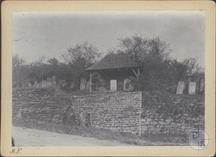 |
 |
| Jewish cemetery in Bibrka, 1892-1897. Photo by Albin Friedrich | Site of Jewish cemetery in Bibrka, 2000 |
During the Soviet occupation (1939-1941), Jewish institutions were dissolved, and political activity was banned. As a result of restrictions imposed on private enterprises, the economic situation of Jews also worsened. After the German invasion of the USSR, the Nazis entered Bibrka on July 1, 1941. The town was administratively part of the Lviv county of the District of Galicia, which from August 1, 1941 became part of the General Government. There were a gendarmerie, criminal police and Ukrainian police stations in Bibrka.
The extermination of the Jewish population of Bibrka in was carried out by the security police from Lviv with the support of the local German gendarmerie and the Ukrainian police. After the establishment of German civil authority in the town, all Jews over the age of 14 were marked, had to register and perform forced labour.
A Judenrat was set up on July 10, 1941. Its chairman was O. Miller. On July 2, 1941, a pogrom was perpetrated in Bibrka. The pretext for carrying it out was the discovery of the bodies of 16 victims of NKVD. Jews were accused of this murder, and Ukrainian nationalists committed a massacre. Several dozen Jews were murdered at that time.
At the end of 1941, a small group of Jewish workers was sent to a labour camp in the village of Kurowice (Ukrainian Куровичі).
In August 1942, Jews from nearby villages and from the settlement of Szczyrec (Ukrainian Щирець) were resettled to Bibrka – 180 people, as well as all the Jewish inhabitants of the settlement of Strzeliska Nowe (Ukrainian Нові Стрілища) - 1252 people.
The number of Jews residing in Bibrka increased to 3,200 people.
The first deportation took place on August 12, 1942. The "action" was carried out by a branch of the security police from Lviv with the help of the local German gendarmerie and the Ukrainian police. About 200 people were murdered on the spot, 1,260 Jews were then transported to the German extermination camp in Belzec.
After this "Action", there were approximately 1,900 Jews in the town.
The ghetto in Bibrka was set up on December 1, 1942. On December 8, 1942, another "Action" was carried out in the ghetto, during which several hundred people were captured. Some of them were deported to Belzec, some perished on the spot. All the Jewish doctors were among the murdered. Until the liquidation of the ghetto, about 300 people died of starvation and diseases.
The ghetto was liquidated on April 13, 1943. This was carried out by units of the security police from Lviv, the German gendarmerie from Bibrka and the local Ukrainian police. At that time, 1,070 Jews from Bibrka were shot near the village of Wolowe. A Jewish hospital with 50 patients was burnt down. A small group of Jews able to work were transported to the Janowska concentration camp in Lviv. Several hundred people managed to escape from the execution site, but almost all of them were caught and murdered.
After 1944, some 40 Jews returned to Bibrka.
The extermination of the Jewish population of Bibrka in was carried out by the security police from Lviv with the support of the local German gendarmerie and the Ukrainian police. After the establishment of German civil authority in the town, all Jews over the age of 14 were marked, had to register and perform forced labour.
A Judenrat was set up on July 10, 1941. Its chairman was O. Miller. On July 2, 1941, a pogrom was perpetrated in Bibrka. The pretext for carrying it out was the discovery of the bodies of 16 victims of NKVD. Jews were accused of this murder, and Ukrainian nationalists committed a massacre. Several dozen Jews were murdered at that time.
At the end of 1941, a small group of Jewish workers was sent to a labour camp in the village of Kurowice (Ukrainian Куровичі).
In August 1942, Jews from nearby villages and from the settlement of Szczyrec (Ukrainian Щирець) were resettled to Bibrka – 180 people, as well as all the Jewish inhabitants of the settlement of Strzeliska Nowe (Ukrainian Нові Стрілища) - 1252 people.
The number of Jews residing in Bibrka increased to 3,200 people.
The first deportation took place on August 12, 1942. The "action" was carried out by a branch of the security police from Lviv with the help of the local German gendarmerie and the Ukrainian police. About 200 people were murdered on the spot, 1,260 Jews were then transported to the German extermination camp in Belzec.
After this "Action", there were approximately 1,900 Jews in the town.
The ghetto in Bibrka was set up on December 1, 1942. On December 8, 1942, another "Action" was carried out in the ghetto, during which several hundred people were captured. Some of them were deported to Belzec, some perished on the spot. All the Jewish doctors were among the murdered. Until the liquidation of the ghetto, about 300 people died of starvation and diseases.
The ghetto was liquidated on April 13, 1943. This was carried out by units of the security police from Lviv, the German gendarmerie from Bibrka and the local Ukrainian police. At that time, 1,070 Jews from Bibrka were shot near the village of Wolowe. A Jewish hospital with 50 patients was burnt down. A small group of Jews able to work were transported to the Janowska concentration camp in Lviv. Several hundred people managed to escape from the execution site, but almost all of them were caught and murdered.
After 1944, some 40 Jews returned to Bibrka.

- Home
- Shtetls
- Vinnytsia region
- Volyn region
- Dnipro region
- Donetsk region
- Zhytomyr region
- Zakarpattia region
- Zaporizhzhia region
- Ivano-Frankivsk region
- Kyiv region
- Kropyvnytskyi region
- Luhansk region
- Lviv region
- Mykolayiv region
- Odessa region
- Poltava region
- Rivne region
- Sumy region
- Ternopil region
- Kharkiv region
- Kherson region
- Khmelnytskyi region
- Chernihiv region
- Chernivtsi region
- Cherkasy region
- Crimea
- Synagogues
- Cemeteries
- Objects & guides
- Old photos
- History
- Contact
Jewish towns of Ukraine
Jewish towns of Ukraine
My shtetl
My shtetl
Donate
